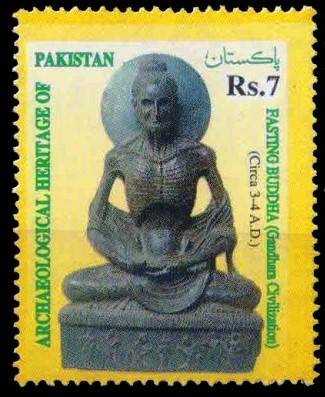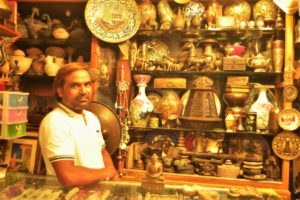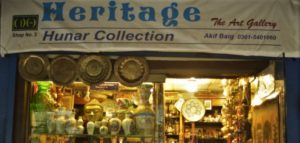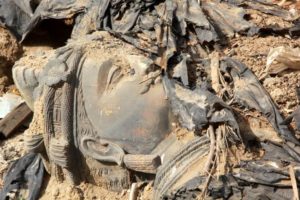
Pakistan has inherited a deep historical past which makes us rich in coveted artifacts. Our heritage goes back farther than recorded human history. However, the institutional arrangements and legal instruments to safeguard these national treasures actually work to promote theft and smuggling instead of protecting our heritage and sustaining the national economy.
We need to change our approach if we are to benefit as a society and economy from our rich cultural heritage. Most of our treasures remain buried as only a few archaeological sites have been excavated to date. We have already discovered priceless national treasures from archaeological and architectural remains of ancient and medieval civilizations that are thousands of years old.

Global markets covet the immensely valuable cultural property. This drives illegal excavations by treasure hunters and sustains powerful mafias that are able to smuggle these out of the country. Museums, auction houses, dealers and private collectors pay massive amounts to buy the smuggled artifacts. Ironically, the trading of archeological artifacts is banned by antiquity laws in Pakistan.
But market demand drives smuggling to cater to a thriving global market of antiquities in the world. The putative links between destruction of archeological heritage sites and museums in source countries and the market for antiquities in the import countries are rarely underlined. There is no way for Pakistan to stop our stolen or illegally excavated artifacts from entering the Western antiquities markets.
Auction houses like Sotheby’s and Christie’s dominate this market. Once artifacts crossed national borders, there is little we can do to stop from it being sold. United Nations Education and Scientific Corporation (UNESCO) spearheaded the first diplomatic attempt in 1970 to develop an international framework for the prevention of export and import of illegal artifacts.
The Convention on the Means of Prohibiting and Preventing the Illicit Import, Export and Transfer of Ownership of Cultural Property has been signed by a majority of the UNESCO member countries.
However, it only serves as a moral force for it is not a binding document to enforce prohibition on the import of illicit antiquities in the rich market countries. Many of these countries are operating under a free market philosophy, in relation to the movement of antiquities and the call for prohibition is seen as contrary to the western ideals of inalienable right to own property.
The art and antiquity laundering through auction houses in the West is no secret. Criminologists and museum experts know how these trading houses facilitate the rich to buy stolen, illegally traded or counterfeit antiquities from around the world.

The auction houses rarely give full details of the provenance of the artifacts as a matter of institutional policy. Instead, they provide only the barest anonymous outlines.
Forged or Falsified provenance documents supplied by the smugglers are readily accepted by these auction houses. According to Interpol figures, the estimated value of illicit trafficking in cultural property comes to around six billion US dollars per year. The response by the Pakistani state to the extreme exploitation of its cultural property has been totally ineffective.
Despite having one of the most stringent antiquity laws in the world – first enacted under a protectionist framework of British colonial rule—the pillage and smuggling of archeological artifacts have reached staggering proportions. The mass of statutory legislations in place only helps the state claim ownership of all antiquities and imposes criminal penalties for stealing such state property.
Legislation also imposes a blanket export prohibition on all antiquities. The reasons for illicit trafficking are not too hard to explain, yet the solution of the problem cannot be found without major rethinking of the current state laws, policies and institutional practices governing Pakistani heritage.
The federal and provincial governments own nearly a thousand sites and monuments across Pakistan while less than one quarter are protected through administration and conservation activities.
As a result, there exist a large numbers of undiscovered archaeological sites in Gandhara artifacts rich Kyber Pakthunkawa (KP). It is the same in the whole of Punjab, Sindh, Balochistan, Gilgit Baltistan and Azad Kashmir. Government’s failure leads to these artifacts falling into private hands. Such pillage and looting of national treasures from prehistoric and illustrious historic civilizations from Mehrgarh –the world’s oldest known civilization—to Harrapa, Moenjodaro, Gandhara, Taxilla and the mighty Mughals.
The scale of Pakistan’s archeological heritage is vast while the state’s financial investment in cultural heritage and the national professional capacity remain paltry. The under-staffed and under-funded departments of archeology and museums have little capacity to excavate, preserve, exhibit and protect our national heritage. Illicit trafficking of national treasures not only impoverishes the nation but it also brings little more than subsistence income to the treasure hunters who are at the bottom of this illegal supply chain.
It is estimated that the 98 percent of the final price of smuggled items end up in the pockets of middle men. Pakistan’s unique and irreplaceable national treasures are being given away by Pakistanis for a small gain and the government is contended with petty policing of smugglers and custom controls.

The real profits of Pakistan’s treasures are harvested by corporate thieves in the rich market countries. It is in there interest to propel illicit trafficking and perpetuate the plunder of archaeological sites in countries like Pakistan. Given the high value of antiquities in the market countries, the antiquities acquired through legitimate or illegitimate means are sold in the lucrative international black markets of cultural property.
This black market is also linked with organised crime and terrorism. Pakistani security experts believe that 10% of the total terror financing in Pakistan used to come through illegal antiquities trade. To retain the national treasures in Pakistan, a set of progressive legislations, based on fresh thinking are needed, which can strike at the deep root of illicit trafficking of antiquities.
UN policy makers and Pakistani archeologist firmly believes that trade in antiquities is wholly undesirable, and can lead to wanton destruction of heritage sites. Given the current scale of unchecked plundering of vast number of unprotected and undiscovered sites in the country, at the hands of crime syndicate of antiquities, this fear is already an everyday reality in Pakistan.
The departments of archaeology and museums have reportedly confessed their institutional inability to check illicit excavations and trafficking of antiquities.
The only way to secure our national treasures is to develop a legitimate domestic market for trading antiquities in the country and exporting it abroad under state control. At a time, when private public partnership is the dominant economic model in the globalized world, Pakistani antiquity laws have denied the right of private sector the legitimate ownership of national heritage and sharing the financial responsibility for its conservation.
If the trade in legally excavated antiquities is liberalised, while making a distinction between the heritage to be preserved and heritage to be locally sold and exported, Pakistani collectors and private dealers will legitimately profit from their ownership of antiquities and the government earn precious foreign exchange by legitimately trading it on the international markets.
The government will earn sufficient funds to invest in the preservation of sites, monuments and museums, as well as run world class university programs in museum studies, to produce a new generation of archaeologists, art historians and anthropologists, who are professionally trained to excavate, protect, preserve and market the national heritage as per its heritage value.
We need to change our approach if we are to benefit as a society and economy from our rich cultural heritage. Most of our treasures remain buried as only a few archaeological sites have been excavated to date. We have already discovered priceless national treasures from archaeological and architectural remains of ancient and medieval civilizations that are thousands of years old.

Global markets covet the immensely valuable cultural property. This drives illegal excavations by treasure hunters and sustains powerful mafias that are able to smuggle these out of the country. Museums, auction houses, dealers and private collectors pay massive amounts to buy the smuggled artifacts. Ironically, the trading of archeological artifacts is banned by antiquity laws in Pakistan.
But market demand drives smuggling to cater to a thriving global market of antiquities in the world. The putative links between destruction of archeological heritage sites and museums in source countries and the market for antiquities in the import countries are rarely underlined. There is no way for Pakistan to stop our stolen or illegally excavated artifacts from entering the Western antiquities markets.
Auction houses like Sotheby’s and Christie’s dominate this market. Once artifacts crossed national borders, there is little we can do to stop from it being sold. United Nations Education and Scientific Corporation (UNESCO) spearheaded the first diplomatic attempt in 1970 to develop an international framework for the prevention of export and import of illegal artifacts.
The Convention on the Means of Prohibiting and Preventing the Illicit Import, Export and Transfer of Ownership of Cultural Property has been signed by a majority of the UNESCO member countries.
However, it only serves as a moral force for it is not a binding document to enforce prohibition on the import of illicit antiquities in the rich market countries. Many of these countries are operating under a free market philosophy, in relation to the movement of antiquities and the call for prohibition is seen as contrary to the western ideals of inalienable right to own property.
The art and antiquity laundering through auction houses in the West is no secret. Criminologists and museum experts know how these trading houses facilitate the rich to buy stolen, illegally traded or counterfeit antiquities from around the world.

The auction houses rarely give full details of the provenance of the artifacts as a matter of institutional policy. Instead, they provide only the barest anonymous outlines.
Forged or Falsified provenance documents supplied by the smugglers are readily accepted by these auction houses. According to Interpol figures, the estimated value of illicit trafficking in cultural property comes to around six billion US dollars per year. The response by the Pakistani state to the extreme exploitation of its cultural property has been totally ineffective.
Despite having one of the most stringent antiquity laws in the world – first enacted under a protectionist framework of British colonial rule—the pillage and smuggling of archeological artifacts have reached staggering proportions. The mass of statutory legislations in place only helps the state claim ownership of all antiquities and imposes criminal penalties for stealing such state property.
Legislation also imposes a blanket export prohibition on all antiquities. The reasons for illicit trafficking are not too hard to explain, yet the solution of the problem cannot be found without major rethinking of the current state laws, policies and institutional practices governing Pakistani heritage.
The federal and provincial governments own nearly a thousand sites and monuments across Pakistan while less than one quarter are protected through administration and conservation activities.
As a result, there exist a large numbers of undiscovered archaeological sites in Gandhara artifacts rich Kyber Pakthunkawa (KP). It is the same in the whole of Punjab, Sindh, Balochistan, Gilgit Baltistan and Azad Kashmir. Government’s failure leads to these artifacts falling into private hands. Such pillage and looting of national treasures from prehistoric and illustrious historic civilizations from Mehrgarh –the world’s oldest known civilization—to Harrapa, Moenjodaro, Gandhara, Taxilla and the mighty Mughals.
The scale of Pakistan’s archeological heritage is vast while the state’s financial investment in cultural heritage and the national professional capacity remain paltry. The under-staffed and under-funded departments of archeology and museums have little capacity to excavate, preserve, exhibit and protect our national heritage. Illicit trafficking of national treasures not only impoverishes the nation but it also brings little more than subsistence income to the treasure hunters who are at the bottom of this illegal supply chain.
It is estimated that the 98 percent of the final price of smuggled items end up in the pockets of middle men. Pakistan’s unique and irreplaceable national treasures are being given away by Pakistanis for a small gain and the government is contended with petty policing of smugglers and custom controls.

The real profits of Pakistan’s treasures are harvested by corporate thieves in the rich market countries. It is in there interest to propel illicit trafficking and perpetuate the plunder of archaeological sites in countries like Pakistan. Given the high value of antiquities in the market countries, the antiquities acquired through legitimate or illegitimate means are sold in the lucrative international black markets of cultural property.
This black market is also linked with organised crime and terrorism. Pakistani security experts believe that 10% of the total terror financing in Pakistan used to come through illegal antiquities trade. To retain the national treasures in Pakistan, a set of progressive legislations, based on fresh thinking are needed, which can strike at the deep root of illicit trafficking of antiquities.
UN policy makers and Pakistani archeologist firmly believes that trade in antiquities is wholly undesirable, and can lead to wanton destruction of heritage sites. Given the current scale of unchecked plundering of vast number of unprotected and undiscovered sites in the country, at the hands of crime syndicate of antiquities, this fear is already an everyday reality in Pakistan.
The departments of archaeology and museums have reportedly confessed their institutional inability to check illicit excavations and trafficking of antiquities.
The only way to secure our national treasures is to develop a legitimate domestic market for trading antiquities in the country and exporting it abroad under state control. At a time, when private public partnership is the dominant economic model in the globalized world, Pakistani antiquity laws have denied the right of private sector the legitimate ownership of national heritage and sharing the financial responsibility for its conservation.
If the trade in legally excavated antiquities is liberalised, while making a distinction between the heritage to be preserved and heritage to be locally sold and exported, Pakistani collectors and private dealers will legitimately profit from their ownership of antiquities and the government earn precious foreign exchange by legitimately trading it on the international markets.
The government will earn sufficient funds to invest in the preservation of sites, monuments and museums, as well as run world class university programs in museum studies, to produce a new generation of archaeologists, art historians and anthropologists, who are professionally trained to excavate, protect, preserve and market the national heritage as per its heritage value.
